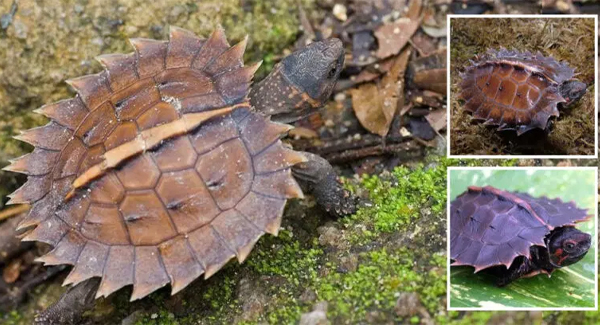The largest freshwater turtle in North America is the spiny turtle (Heosemys spinosa). Spiny turtles, a rare freshwater turtle species from Southeast Asia, feature sharp and pointed carapaces with spiny keels, albeit the edged carapace and spines on their back have worn down with age. Adult spiny back turtles, on the other hand, have spineless and considerably smoother carapaces. However, as youngsters, their spines are sharp with pointed edges, and males have more spines than females. This turtle is found mostly in hill regions with elevations exceeding 2952 feet (900 meters) along little streams, although it may also be found in lowlands and untamed rainforests.

Their smooth, fragile, and rubber-like shells, as well as the form of their carapace, distinguish them from other turtle species. They are also known as cog-wheel turtles because of their spiky shell. Because of their predatory nature, these unique turtle species are critical to the environment. However, they are prey to some of the bigger carnivorous fish species, as well as humans. There are a few turtles that appear like box turtles and softshell turtles that can be found in the untamed forest or in shallow streams. Spiny turtles (Heosemys spinosa) have spines on their keels as well as a soft, rubbery carapace with spiky indentation edges.

Female turtles have fewer backbones than males. A fully developed female turtle’s carapace may measure up to 19 in (48.26 cm), whereas a male’s carapace can measure 5-10 in (12-25 cm). Spines in immature turtles are sharp and edgy, and they are distributed throughout the body. However, as they mature, their spines wear down, and large elderly turtles have spineless carapaces. Their nose is shaped like a pig’s, and their feet are completely webbed, allowing them to swim. Their carapaces are typically brown, and their heads are grey with yellow patches around the eyes.

To avoid danger, their body color allows them to hide amid leaves and plants in the forest. Spiny turtles range in size from 7 to 19 inches (18 to 48 cm) and can weigh up to 25 pounds (11 kg). They are double the size of box and map turtles. Turtles are regarded to be sluggish animals, yet when agitated, this species can travel quickly both in land and in water; inland, its speed has been seen to approach 15 mph (24 kph). The food of a spiny turtle consists of everything that fits in its mouth. They are omnivorous species that can live on both fruits and tiny aquatic critters.

They burrow themselves in the mud and stick their heads above ground to grab them. Their food consists primarily of aquatic invertebrates such as mole crickets and crayfish, as well as rare fish like shrimp. Spiny turtle habitat includes freshwater and small streams in untamed rainforest, timber, hill, and mountains. They may survive both beneath the water and on land in cool and shaded areas. Their range is primarily limited to Southeast Asia and the Sumatra and Borneo islands. During the rainy season, the spiny turtle’s reproductive activity is enhanced.

The male turtle nudges the female’s brow, and if she decides to mate, he floats above her without clasping her with his claws, as is their conventional reproduction method. In captivity, reproduction is staged; male turtles are encouraged by spraying water, and then they chase female turtles to mount them for breeding. Each season, females deposit three to four eggs. In order for the female to produce so large eggs, a hinge grows in her shell for flexibility. The adorable spiny turtle is a low-maintenance pet. They may be housed in big tanks ranging from 75 to 100 gallons (284-378 l). The water must be maintained clean, and no sharp items should be kept close by since they might hurt its softshell.


